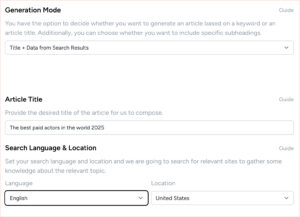Understanding how Semantic SEO and user intent intersect is crucial for driving organic traffic and improving user experience.
By harnessing the power of semantic search, search engines can better grasp the context and meaning behind user queries, leading to more relevant search results. This, in turn, enhances user satisfaction and increases the likelihood of conversions.
In this article, we will explore how Semantic SEO techniques can align with user intent to create a more effective and user-friendly online presence.
Understanding Semantic SEO
To grasp the concept of Semantic SEO, you must understand how search engines interpret the context and meaning behind user queries. Semantic SEO focuses on the relationship between words, phrases and their intended meanings. By optimising content with relevant keywords and contextually related terms, you can enhance your website’s visibility in search engine results.
Search engines like Google analyse the relevance and depth of content to provide users with the most accurate and valuable information. By comprehending the meaning of words, phrases, and concepts, they provide more accurate and relevant results.
Utilising structured data markup, natural language processing, and machine learning semantic search engines aim to deliver a better user experience. To optimise your website for these engines, focus on creating high-quality, relevant content that aligns with user intent.
This approach goes beyond traditional keyword optimisation, emphasising the importance of natural language and user intent. By aligning your content with semantic search principles, you can improve your website’s ranking and better meet the needs of your target audience.
Importance of User Intent
Understanding user intent is crucial for optimising your website’s performance in search engine results. By comprehending what users are looking for when they type in a search query, you can tailor your content to meet their needs effectively.
User intent falls into four main categories:
- Informational Intent: Users are seeking information or answers to specific questions. They want to learn about a topic, process or concept.
- Examples: “How to bake a cake,” “What is semantic SEO,” and “Benefits of drinking water.”
- Content Strategy: Create comprehensive, well-researched, and easy-to-understand content. Use blog posts, how-to guides, tutorials, infographics and videos. Ensure the content answers common questions and provides value.
- Navigational Intent: Users are trying to locate a specific website or web page. They already know where they want to go.
- Examples: “Facebook login,” “YouTube,” “CNN homepage.”
- Content Strategy: Ensure your brand’s website is well-optimised for search engines with clear navigation paths. Use site links and optimise for branded keywords to help users find your site easily. Ensure your site appears in search results for your brand-related queries.
- Transactional Intent: Users are ready to make a purchase or complete a specific action. They have a clear intention to buy something or sign up for a service.
- Examples: “Buy iPhone 13,” “Cheap flights to New York,” and “Sign up for Netflix.”
- Content Strategy: Optimise product pages, include clear calls-to-action (CTAs) and ensure a smooth user experience with easy navigation and fast load times. Use persuasive copy, customer reviews and secure checkout processes. Implement schema markup for products and services to enhance visibility in search results.
- Commercial Investigation Intent: Users are researching products or services and comparing options before making a purchase decision. They are in the consideration phase.
- Examples: “Best smartphones 2024,” “Top SEO tools,” “iPhone 13 vs Samsung Galaxy S21.”
- Content Strategy: Create comparison guides, product reviews, buying guides and detailed product descriptions. Highlight key features, benefits and user reviews. Use lists, charts and videos to provide thorough comparisons and assist users in their decision-making process.
Implementing Semantic SEO for Different User Intents
- Keyword Research: Use tools like Google Keyword Planner, SEMrush, or Ahrefs to find keywords related to each intent. Focus on long-tail keywords for informational and commercial investigation intents.
- Content Structure: Organise content logically with headers, bullet points, and short paragraphs. Use schema markup to help search engines understand the content structure.
- Internal Linking: Link related content to provide a better user experience and help search engines understand the content’s context.
- User Experience: Ensure your website is mobile-friendly, fast-loading, and easy to navigate to meet the needs of users with different intents.
By aligning your content strategy with these user intent categories, you can improve your SEO performance and provide a better experience for your audience.
Leveraging Natural Language Processing
Leverage Natural Language Processing (NLP) to optimize your website’s content for semantic SEO and improve user intent understanding. By utilizing NLP technology, you can analyze and interpret the language patterns used by your audience, allowing you to create more relevant and targeted content.
NLP tools can help identify user intent behind search queries, enabling you to tailor your content to meet those specific needs. Make the most of NLP capabilities to ensure that your content resonates with your target audience and aligns with search engine algorithms for improved visibility and relevance.
Measuring Success in Semantic SEO
To gauge the effectiveness of your semantic SEO efforts, focus on tracking key performance indicators that reflect improved user engagement and search engine visibility.
- Monitor metrics like organic traffic growth, click-through rates, time on page and bounce rates to assess user behaviour.
- Analyse keyword rankings, featured snippets and structured data implementation to measure search engine visibility enhancements.
- Utilise tools such as Google Analytics, Google Search Console, and SEO platforms to gather insightful data.
- Conduct regular content audits to ensure alignment with semantic SEO strategies.
By consistently evaluating these metrics and making data-driven adjustments, you can effectively measure the success of your semantic SEO initiatives and optimize for user intent and search engine requirements.
Can user intent be accurately predicted using semantic SEO techniques?
When trying to predict user intent, consider various factors like search history, demographics, and context.
It’s essential to analyse data effectively to make accurate predictions and tailor your strategies to meet users’ needs.
Conclusion
By incorporating Semantic SEO strategies, you can align your content with what users are searching for, ultimately driving more relevant traffic to your website.
Remember, catering to user intent not only boosts your search engine rankings but also enhances the overall user experience. Stay ahead by continuously optimising your content to meet the evolving needs and preferences of your audience.





